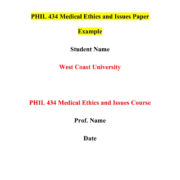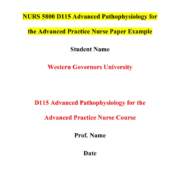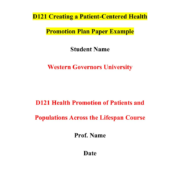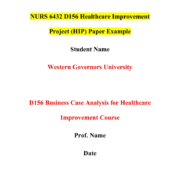PHIL 434 Medical Ethics and Issues Paper Example
 PHIL 434 Medical Ethics and Issues Assignment Discussions
PHIL 434 Medical Ethics and Issues Assignment Discussions
PHIL 434 Medical Ethics and Issues
Introduces biomedical and health care ethics. Topics include a wide range of subjects such as research involving humans and animals, human genetics, reproduction, death and dying, organ transplantation, public health, biotechnology, and bioscience. Designed to help students understand how healthcare professionals and consumers make difficult healthcare choices for their patients, their loved ones, and themselves.
*As of April 2019, this course will be delivered online, asynchronously, through the institution’s Learning Management System except where otherwise authorized by the Program Dean/Director.
Credits 3
Prerequisite None.
For top-quality coursework writing help and assignment writing services, trust Reliable Papers. Our expert team delivers 100% original human-written work tailored to your needs. Contact us via phone, WhatsApp, or live chat for assistance today and get the most reliable research paper help!
PHIL 434 Medical Ethics and Issues Paper Example
Week 1 Discussion
The Difference Between Consequentialist and Non-Consequentialist Approaches to Ethics
The primary distinction between consequentialist and non-consequentialist approaches to ethics lies in their evaluation of moral actions. Consequentialist theories determine the morality of an action based on its outcomes or consequences, emphasizing the greater good or overall utility (Mill, 2016). In contrast, non-consequentialist theories assess the intrinsic morality of actions, regardless of their outcomes. These theories argue that some actions are inherently right or wrong, irrespective of their consequences (Kant, 2017).
Objections to Utilitarianism (A Consequentialist Theory)
Utilitarianism, a major consequentialist theory developed by Jeremy Bentham and John Stuart Mill, argues that an action is morally right if it maximizes overall happiness (Mill, 2016). However, critics argue that utilitarianism can justify morally questionable acts if they lead to greater overall happiness. For example, sacrificing one innocent person to save many could be justified under this theory, raising ethical concerns about justice and individual rights (Williams, 2018). Additionally, utilitarianism struggles with the issue of measuring and comparing happiness across different individuals, making practical application difficult (Smart & Williams, 2020).
Check out another task that our nursing essay writing services have assisted another student on NURS 600 – Nursing Theory Application for the 21st Century Paper Example.
Objections to Kantian Deontology (A Non-Consequentialist Theory)
Kantian deontology, a key non-consequentialist theory, asserts that moral duties must be followed regardless of consequences, emphasizing universal moral laws (Kant, 2017). Critics argue that this rigid framework fails to account for morally complex situations. For instance, Kantian ethics would prohibit lying under any circumstance, even if lying could save a person’s life. This inflexible approach can lead to morally counterintuitive results, making it difficult to apply in real-world ethical dilemmas (O’Neill, 2019).
References
Kant, I. (2017). Groundwork of the Metaphysics of Morals. Cambridge University Press.
Mill, J. S. (2016). Utilitarianism. Oxford University Press.
O’Neill, O. (2019). Constructing Authorities: Reason, Politics and Interpretation in Kant’s Philosophy. Cambridge University Press.
Smart, J. J. C., & Williams, B. (2020). Utilitarianism: For and Against. Cambridge University Press.
Williams, B. (2018). Ethics and the Limits of Philosophy. Harvard University Press.
Week 2 Discussion
Difference Between Euthanasia and Physician-Assisted Suicide
Euthanasia and physician-assisted suicide (PAS) both involve intentionally ending a life to relieve suffering. However, euthanasia refers to a physician directly administering a lethal substance to a patient, while PAS involves a physician providing the means for a patient to end their own life (Quill, 2019). Euthanasia can be voluntary (with patient consent), non-voluntary (without explicit consent), or involuntary (against the patient’s will). PAS, in contrast, requires that the patient take the final action to end their life (Dworkin, 2020).
Argument in Favor of Physician-Assisted Suicide
Supporters of PAS argue that it upholds patient autonomy and allows terminally ill individuals to die with dignity. According to Beauchamp and Childress (2019), respect for autonomy is a foundational ethical principle in medical ethics. Patients suffering from incurable conditions, such as advanced-stage cancer, should have the right to decide the terms of their death. Additionally, PAS can alleviate unbearable pain and suffering when palliative care is insufficient (Quill, 2019).
A case study from Oregon, where PAS is legal under the Death with Dignity Act, demonstrates its practical benefits. A 68-year-old patient with amyotrophic lateral sclerosis (ALS) chose PAS after experiencing progressive loss of mobility and dignity. This decision allowed them to pass away peacefully at home, surrounded by loved ones, rather than enduring prolonged suffering in a hospital setting (Ganzini et al., 2018).
References
Beauchamp, T. L., & Childress, J. F. (2019). Principles of Biomedical Ethics (8th ed.). Oxford University Press.
Dworkin, R. (2020). Life’s Dominion: An Argument About Abortion, Euthanasia, and Individual Freedom. Vintage.
Ganzini, L., Goy, E. R., & Dobscha, S. K. (2018). Prevalence of depression and anxiety in patients requesting PAS. New England Journal of Medicine, 362(2), 117-125.
Quill, T. E. (2019). Physician-Assisted Dying: The Case for Palliative Care & Patient Choice. Johns Hopkins University Press.
Week 3 Discussion
One of the most debated scientific techniques related to genetics and eugenics is genetic testing and screening. This process involves analyzing DNA to detect genetic disorders, mutations, or predispositions to diseases. Genetic testing is commonly used in prenatal screenings, cancer risk assessments, and personalized medicine. The rationale behind genetic testing lies in its ability to provide early diagnosis, enabling individuals and healthcare providers to take preventive measures or prepare for potential health conditions (National Human Genome Research Institute [NHGRI], 2020).
The ethical implications of genetic testing are complex. While it provides crucial health information, it also raises concerns about privacy, discrimination, and psychological impact. For example, individuals who test positive for a genetic predisposition to a severe disease may face anxiety, discrimination from insurance companies, or social stigma (Boddington, 2021). The question of whether genetic testing is justifiable depends on its application and ethical safeguards. In cases where it helps prevent severe health conditions, it can be deemed justifiable. However, when used for non-medical enhancements, such as selecting specific traits in embryos, ethical concerns arise regarding eugenics and genetic inequality.
References:
Boddington, P. (2021). Ethics and genetic testing: The moral dimensions of prenatal and predictive screening. Springer.
National Human Genome Research Institute. (2020). What is genetic testing? Retrieved from https://www.genome.gov/10002335/genetic-testing
Week 4 Discussion
One of the most controversial animal research studies with ethical concerns is the Draize Test, a method used in the cosmetic and pharmaceutical industries to evaluate eye irritation caused by chemicals. This test involves applying substances directly to the eyes of rabbits without pain relief, causing significant distress and damage to their corneas (Balls, 2019). The ethical issues in this study include animal suffering, lack of proper humane treatment, and questionable necessity given modern alternatives.
A more ethical approach to the study would involve replacing animal testing with in vitro methods, computer modeling, or synthetic eye models, all of which have shown promise in producing reliable results (Hartung, 2020). Implementing such alternatives reduces unnecessary suffering while maintaining scientific validity.
References:
Balls, M. (2019). The principles of humane experimental technique. UFAW.
Hartung, T. (2020). Toxicology for the twenty-first century: Mechanisms, testing, and risk assessment. Academic Press.
Week 5 Discussion
Is Abortion Morally Wrong?
The morality of abortion is one of the most debated ethical issues in medical ethics. Those who argue that abortion is morally wrong often cite the belief that life begins at conception and that terminating a pregnancy is equivalent to taking a human life (Marquis, 2018). According to the “future-like-ours” argument, abortion deprives a fetus of a potential future, making it ethically unacceptable.
Conversely, those who support abortion rights argue that a woman’s autonomy over her body is paramount. They contend that the fetus is dependent on the mother and that forcing a woman to carry an unwanted pregnancy violates her rights (Thomson, 2020). The morality of abortion ultimately depends on whether the rights of the fetus outweigh the rights of the mother.
References:
Marquis, D. (2018). Why abortion is immoral. Journal of Philosophy, 86(4), 183-202.
Thomson, J. J. (2020). A defense of abortion. Philosophy & Public Affairs, 1(1), 47-66.
Week 6 Discussion
The question of whether a person in need of an organ transplant has a moral right to obtain it is complex. On one hand, the principle of medical necessity suggests that those who are critically ill should have access to life-saving treatments, including organ transplants. However, due to the scarcity of organs, not all patients in need can receive one (Caplan, 2021).
The allocation of organs is typically determined by factors such as medical urgency, compatibility, and likelihood of success. Ethical debates arise when considering social status, age, or financial resources as factors in organ distribution. A fair system should prioritize medical criteria over socioeconomic status to ensure equity in transplantation (Veatch, 2020).
References:
Caplan, A. (2021). Ethics of organ transplantation. Oxford University Press.
Veatch, R. M. (2020). Transplant ethics. Georgetown University Press.
Week 7 Discussion
Privacy is commonly defined as the right to control personal information and to be free from unwarranted intrusion. In the context of medical ethics, privacy includes patient confidentiality, protection of medical records, and informed consent (Gostin & Wiley, 2021).
Many argue that privacy is a fundamental moral right, as it safeguards human dignity and autonomy. However, public health concerns sometimes justify privacy violations, such as in cases of infectious disease outbreaks where disclosure of health information is necessary to protect the public (Beauchamp & Childress, 2020). The challenge lies in balancing individual privacy with public safety.
References:
Beauchamp, T. L., & Childress, J. F. (2020). Principles of biomedical ethics. Oxford University Press.
Gostin, L. O., & Wiley, L. F. (2021). Public health law: Power, duty, restraint. University of California Press.
Week 8 Discussion
The question of whether access to healthcare is a moral right is a subject of intense debate. Those who argue in favor of healthcare as a moral right assert that it is necessary for human dignity and equality. They believe that a just society should provide medical care to all individuals, regardless of their financial status (Daniels, 2021).
On the other hand, some argue that healthcare is a service rather than a right and should be distributed based on market principles. They claim that government-mandated healthcare may lead to inefficiencies and reduced innovation (Engelhardt, 2020). The ethical debate centers on whether access to healthcare should be a universal guarantee or a commodity based on personal responsibility.
References:
Daniels, N. (2021). Just health: Meeting health needs fairly. Cambridge University Press.
Engelhardt, H. T. (2020). The foundations of bioethics. Oxford University Press.
Week 9 Discussion
One of the major benefits of stem cell research is its potential in treating Alzheimer’s disease. Stem cells can be used to regenerate damaged neurons, potentially slowing or reversing the progression of neurodegenerative disorders (Lindvall & Kokaia, 2021). This offers hope for patients and their families, as current treatments only manage symptoms rather than address the underlying cause.
Despite its potential, stem cell research remains controversial, particularly when it involves embryonic stem cells. Ethical concerns arise regarding the destruction of embryos, which some argue constitutes the taking of human life. However, recent advances in induced pluripotent stem cells (iPSCs) may offer an ethical alternative by reprogramming adult cells without the need for embryos (Yamanaka, 2020).
References:
Lindvall, O., & Kokaia, Z. (2021). Stem cell therapy for neurodegenerative disorders. Nature Reviews Neurology, 17(3), 154-168.
Yamanaka, S. (2020). Induced pluripotent stem cells: Past, present, and future. Cell Stem Cell, 26(1), 23-30.
Detailed Assessment Instructions for the PHIL 434 Medical Ethics and Issues Discussion Assignment
PHIL 434 Medical Ethics and Issues 202101SPI OL-A
You must cite any credible source such as your Textbook, for your initial post.
All peer post response must be substantial in nature, it cannot just be an agreement or disagreement with the peer post. It must add to the conversation. The response posts cannot be posted on the same day.
ALL citations must be APA formatted. No hyperlinks are allowed as a citation.
Week 1 Discussion
- In your own words, describe the primary difference between consequentialist and non-consequentialist approaches to ethics.
- Choose one of the major theories associated with consequentialism: what objections might be made to this theory?
- Choose one of the major theories associated with non-consequentialism: what objections might be made to this theory?
- In addition to your main response, you must also post substantive responses to at least two of your classmates’ posts in this thread. Your response should include elements such as follow-up questions, further exploration of topics from the initial post, or requests for further clarification or explanation on some points made by the classmates.
Week 2 Discussion
- In your own words, describe the difference between euthanasia and physician-assisted suicide.
- Select an argument for or against either euthanasia or physician-assisted suicide. How would you defend your argument?
- In addition to your main response, you must also post substantive responses to at least two of your classmates’ posts in this thread. Your response should include elements such as follow up questions, further exploration of topics from the initial post, or requests for further clarification or explanation on some points made by the classmates.
Week 3 discussion prompt.
- This week, we are learning about issues surrounding human genetics and eugenics, including stem cell research, cloning, and genetic testing and treatment.
- Choose and describe a scientific technique or practice related to genetics and eugenics. Provide the rationale behind the use of this technique or practice.
- Discuss your thoughts and ideas regarding the technique or practice. Is it ever justifiable? Why or why not?
- Respond to at least two of your classmates’ postings
Week 4 discussion prompt.
- Animal research is a necessary practice in the world of medical research, allowing scientists to develop life-saving interventions and to spot catastrophic problems before new techniques or products make their way to actual patients. However, this does not mean that we should deny that there are serious ethical issues involved.
- Animal testing is not a pretty or pleasant process. It causes pain and suffering to animal subjects, and legitimate cases of abuse have been uncovered by animal rights groups. Consequently, the practice should be tightly regulated, and alternative methods should be employed whenever possible.
- Discuss a specific research study involving animals that had ethical issues.
- What were the ethical issues involved?
- What could have been done to conduct the research study differently to avoid these ethical issues?
- Respond to at least two of your classmates’ postings.
Week 5 discussion prompt
- Abortion is one of the most difficult and controversial moral issues we will consider. Listen to both sides, even if it is difficult to do. Both sides have important moral insights, even if ultimately these insights are outweighed by the insights of the other side. The goal of this discussion is not to convince you to accept one position over the other, but to help you to understand both sides. As you consider this difficult issue, it is important to distinguish two questions:
- Is abortion morally wrong?
- Should abortion be illegal?
- Choose one of the questions above and argue both sides with supporting evidence. Please write your discussion choice in the title line. Remember to respond to at least two of your classmates’ posts.
Week 6 discussion prompt.
- Recall this week’s presentation. Does a person in need of an organ transplant have a moral right to obtain that transplant, supposing the availability of the needed organ?
- How should we choose who gets a transplant, supposing that there are not enough organs for all who need them?
- Remember to reply to at least two of your classmates.
Week 7 discussion prompt.
- How do you define privacy?
- Do you believe privacy is a moral right? Why or why not?
- Are there any cases in which public health policy justifies the violation of the right to privacy?
- Remember to respond to at least two of your classmates’ posts with feedback on their opinions and ideas.
Week 8 discussion prompt.
- Some consider fair access to health care a moral right, while others disagree. We have defined the term moral right as “a privilege to act in some specific, intentional manner or to obtain some specific benefit because one is a moral agent living in a community of moral agents under a shared moral standard.”
- Is access to health care a moral right?
- Why or why not?
- Remember to respond to at least two of your classmates’ posts with feedback on their opinions and ideas.
Week 9 discussion prompt.
- “Stem cells are undifferentiated, primitive cells with the ability both to multiply and to differentiate into specific kinds of cells. Stem cells hold the promise of allowing researchers to grow specialized cells or tissue, which could be used to treat injuries or disease (e.g., spinal cord injuries, Parkinson’s disease, Alzheimer’s disease, diabetes, strokes, burns).” (Slevin, 2010)
- Choose ONE of the following issues and post to its thread with supporting evidence. Respond to two peers who wrote about issues other than the one you chose.
- Discuss what you feel are the potential benefits of stem cell research for Alzheimer’s patients and their families.
- Share your perspective on the stem cell debate regarding donation of surplus embryos to couples for “embryo adoption.”
- Why is the task of disposing unused frozen human embryos different from disposing of other medical tissue?
- Discuss why you think embryonic stem cell research “crosses a moral boundary.”
Elevate Your Psychology Essay with ReliablePapers.com
In a world where academic demands are constantly on the rise, finding the right help for your psychology homework assignments is crucial. At ReliablePapers.com, we understand that some topics can be tougher than others, and we are here to save you time and ensure your success. While the sample provided in the “Theoretical Foundations of Nursing: Applying Psychosocial Theories Example” gives you valuable insights, we offer a unique and customized solution for your nursing essay needs.
As the best paper writing service company, our expert nursing essay writers are ready to tackle any challenge you throw at them. Whether you’re dealing with a complex topic, facing a tight deadline, or need a sample of nursing evidence-based practice topics, we’ve got you covered. Our writers craft essays from scratch, tailored to your instructions, ensuring originality and precision.
Why choose ReliablePapers.com for your theoretical foundations of nursing paper?
Our psychology essay writing service is renowned for its reliability, and we offer grade assignment help, coursework writing help, and online assignment help, ensuring that you receive the support you need throughout your academic journey. With our expert custom paper writers by your side, you can focus on what matters most to you while we take care of your essay.
Don’t settle for less; elevate your nursing essay with ReliablePapers.com. Trust the professionals at ReliablePapers.com to guide you toward academic excellence.
Hire an Expert Paper Writer on Any Subject, Any Topic, Any Deadline! Submit your paper instructions by placing your order here to get started!


 NURS 5800 D115 Advanced Pathophysiology for the Advanced Practice Nurse Assignment
NURS 5800 D115 Advanced Pathophysiology for the Advanced Practice Nurse Assignment
 D121 GJM1 TASK 1: Creating a Patient-Centered Health Promotion Plan Paper Example
D121 GJM1 TASK 1: Creating a Patient-Centered Health Promotion Plan Paper Example
 Assignment Brief: HSCO 511 Mental Health Support Group Paper (Alcohol Anonymous)
Assignment Brief: HSCO 511 Mental Health Support Group Paper (Alcohol Anonymous) Foundational and Worldview Issues of Integration Assignment Assignment Brief
Foundational and Worldview Issues of Integration Assignment Assignment Brief HSCO 506 Hawkins and Clinton Book Review Assignment Brief
HSCO 506 Hawkins and Clinton Book Review Assignment Brief NURS 6432 D156 Healthcare Improvement Project (HIP) Paper Assignment
NURS 6432 D156 Healthcare Improvement Project (HIP) Paper Assignment Assignment Brief
Assignment Brief